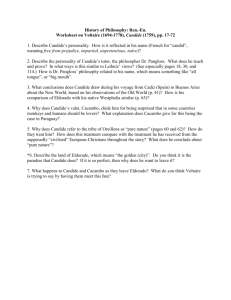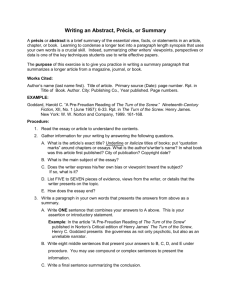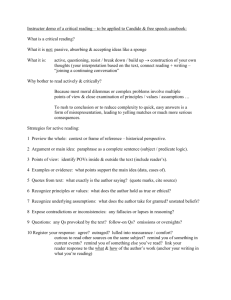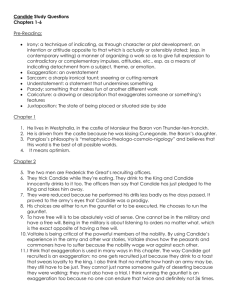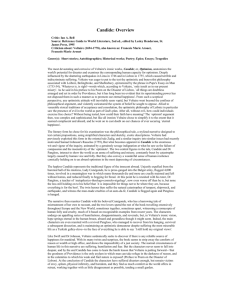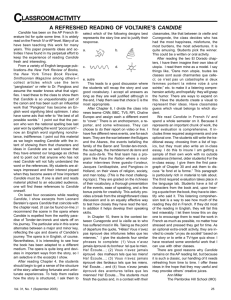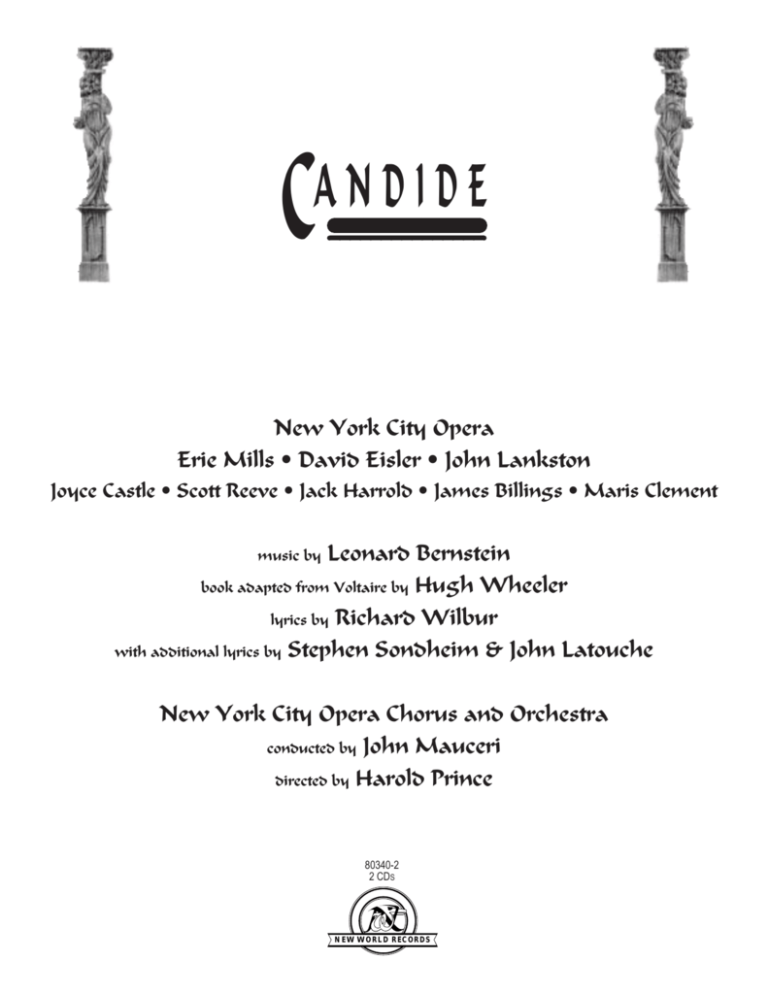
C
ANDIDE
New York City Opera
Erie Mills ¥ David Eisler ¥ John Lankston
Joyce Castle ¥ Scott Reeve ¥ Jack Harrold ¥ James Billings ¥ Maris Clement
Leonard Bernstein
book adapted from Voltaire by Hugh Wheeler
lyrics by Richard Wilbur
with additional lyrics by Stephen Sondheim & John Latouche
music by
New York City Opera Chorus and Orchestra
conducted by John Mauceri
directed by Harold Prince
80340-2
2 CDS
NEW WORLD RECORDS
C
ANDIDE
M
uch like the leading character in the Voltaire
novel, Leonard Bernstein's Candide has managed to keep reappearing time and time again
in the face of formidable odds. Candide journeys throughout the world guided by the lessons of his optimistic teacher, Dr. Pangloss: all is for the best, everything is
made for a purpose, and is, therefore, made for the best of all
possible purposes in this best of all possible worlds. At the
end of his journey, after witnessing death, murder, earthquakes, hangings, and disasters, (the best of all possible
deaths, murders, etc.) Candide returns to Westphalia, concluding that his place is at home, cultivating his own garden.
Leonard Bernstein's musical adaptation of Candide started life in 1956 as a musical comedy, became an operetta, was
heard several times in concert form, and if not home to
roost once and for all in this recorded version, is certainly
being cultivated in the place many felt it belonged from the
very beginning—the opera house.
In 1956 Leonard Bernstein was already one of the most
important figures on the American musical scene. In
October alone, his appointment as co-musical director of the
New York Philharmonic for the 1957-58 season was
announced; his highly acclaimed Omnibus television program analyzing the American musical was broadcast nationally; and his third musical for Broadway (after On the Town
in 1944 and Wonderful Town in 1953) was in rehearsal prior
to its tryout engagement. Billed simply as “a musical”
Candide played its first performance on October 29th at
Boston's Colonial Theatre.
His collaborators were an extraordinary group of literary
giants for whom the creation of a musical was by and large a
new experience. The libretto was adapted from Voltaire by
Lillian Hellman, who had never before worked on a musical
(rumor had it she was interested in drawing a parallel
between Candide's blind faith in Dr. Pangloss's teachings and
the rampant paranoia of the McCarthy era of the 1950s); the
lyrics were begun by John Latouche and finished by the
poet Richard Wilbur, with contributions from Dorothy
Parker, Leonard Bernstein, and Lillian Hellman. Tyrone
Guthrie was the director, and although he had staged many
operas this too was his initial foray into the creation of a
new American musical. The scenery and costumes were by
veterans Oliver Smith and Irene Sharaff.This group was incapable of creating an average musical comedy (if such a thing
exists) even if they had tried. And clearly they did not.
Voltaire's satire, although slight and humorous in style, was
aimed against the optimistic philosophies of the 18th century, and the musical version, as originally conceived, was
equally concerned with satire, perhaps too much so for its
own good.The approach was decidedly serious, and the casting tended toward the operatic—Robert Rounseville, Irra
Petina, Max Adrian, and Barbara Cook—which was necessary
to handle the intricacies of Bernstein's eclectic score. The
wit of Voltaire's words was entrusted to Ms. Hellman’s adaptation and to the lyrics.
However noble the intentions of the project, Candide
opened in Boston to decidedly mixed reviews. The score
was praised, and everyone agreed that the show was opulent and extravagant (it cost $350,000, then high for a musical). However, most critics had problems with the piece
itself. “It seems incredible,” wrote Cyrus Durgin in the
Morning Globe, “when you think of all the talent involved,
that Candide should have proved so sorry an entertainment.” Elliot Norton, dean of Boston theater critics, found it
“clumsy and plodding” (the Record); George E. Ryan in the
Pilot called it “pretentious and freighted with allegory and
symbol;” and Edwin F. Melvin said in the Christian Science
Monitor that it seemed “as disjointed and pointless as a fantastic dream.”There were supporters, however, starting with
Variety's Boston stringer, who reported that the show was “a
spectacular, opulent, and racy musical verging on operetta.”
The American's Peggy Doyle wrote: “Candide is easily the
most fantastically beautiful and imaginative production as
well as the most exciting musically this season.”
The controversy surrounding Candide began on opening
night: what exactly was it? musical comedy? opera?
operetta? The Boston Globe critic took the position that
“perhaps had it been produced by some organization such
as the Metropolitan Opera or the New York City Opera and
treated as an opera and sung in French or Italian it might be
regarded as an art work in the near future.” Alta Maloney of
the Boston Traveler said: “.... the collaborators have turned
out something that the Metropolitan Opera might be doing
in a few years.” Leonard Bernstein himself tackled the ques-
2
tion in a self-interview published in the New York Times
shortly before the New York opening:
Voltaire with earnest philosophizing; she seemed to fight
any sense of burlesque or ribald humor The Entertainment
Newsletter of February 16, 1957, summed up the whole
venture in typical show-biz verbiage: “What happened was
that they put in too much longhair for Joe Schmoe, and too
much crap for the long-hair crew.”
It didn't take long for one element of Candide to catch
on with the public—the overture. It became, and still is, one
of the most often played American works in the concert
repertoire around the world. It has been recorded numerous
times, and by Bernstein himself on at least three occasions.
Shortly after the New York closing, a road company
toured this country in a scaled-down version and a production opened in London. Although it took years before the
work gained widespread audience approval, interest in producing it never really waned. Gordon Davidson, the innovative director of the Mark Taper Forum in Los Angeles, helped
land that job by his staging of a successful production at the
Theater Group of UCLA in 1966. Performed in the style of a
beggars' opera, Davidson's production ventured to retrieve
some of the irreverence and spirit of Voltaire. Different
locales were represented by found objects instead of elaborate scenery. Dr. Pangloss was played by a pre-Archie Bunker
Carroll O’Connor, to whom Davidson gave additional lines
from Voltaire—the beginnings of the notion of Voltaire himself as a character in the show. Sheldon Patinkin, an original
member of the Second City troupe, began a commitment to
Candide in 1967 by producing the first concert version in
an outdoor summer presentation at Grant Park in Chicago.
This led to a concer t performance in New York at
Philharmonic Hall (now Avery Fisher Hall) on November 10,
1968, celebrating Bernstein's 50th birthday.That cast included Madeline Kahn as Cunegonde, showing the coloratura
soprano she seems to have kept hidden from the world ever
since, and Alan Arkin as Dr. Pangloss and two other characters: the Narrator, which Patinkin added to help clarify the
confusing episodic nature of the plot, and Martin, the pessimistic scholar whom Voltaire uses to show Candide the
opposite of Pangloss's philosophy. (In the subsequent
Broadway and Opera House versions, the Narrator has
evolved into Voltaire himself.)
In the wake of that performance's success Edwin Lester
of the Los Angeles Civic Light Opera together with Roger L.
Stevens decided to mount a full-scale revival in the summer
of 1971. The idea was to take Patinkin's successful concert
adaptation, reinstate some of the music that had been discarded or rewritten, and create a “definitive” Candide. (One
piece of music excised very early on was to appear in
Bernstein's West Side Story as “One Hand, One Heart.” That
was enough to make people curious about digging into the
trunk to see what else had been put aside.)
Bernstein wrote words and music for a new song for
Martin, entitled “Words,Words,Words,” and included within it
a reprise of “The Best of All Possible Worlds” using a pessimistic version of the lyric, “the worst of all possible
worlds?”After San Francisco and Los Angeles, the production
was to play the newly opened John F. Kennedy Center in
Washington and then return to Broadway. The cast, drawn
from both musical theater and opera, was highlighted by
Mary Costa, who managed the nine high E flats and even
L.B.: Candide is beginning to look to me like a real
fine old-fashioned operetta, or a comic opera, or an
opera-comique, or whatever that list of yours was. But
not a musical comedy surely?
L.B.: Who ever said it wasn't an operetta?... Of
course it's a kind of operetta, or some version of musical theater that is basically European but which
Americans have long ago accepted and come to love.
By the time Candide opened at the Martin Beck Theatre
in New York on December 1, 1956, this question was clarified somewhat by changing the billing from “a musical” to “a
comic operetta.” But the identity of the piece remained
unclear. Boston had seen some changes, including the addition of “What's the Use” in the Venice scene and the altering
of Candide and Cunegonde's first musical moments in Act I
(which unfortunately eliminated the introduction of
Candide's leitmotif), but the style and feel of the production
were unaltered. As a result, the reaction in New York was
much the same as in Boston, but more heated. Walter Kerr
began his Herald Tribune review by writing: “Three of the
most talented people our Theater possesses—Lillian
Hellman, Leonard Bernstein, and Tyrone Guthrie—have
joined hands transforming Voltaire's Candide into a really
spectacular disaster.” Brooks Atkinson, taking the opposing
view in the Times, said it was “a triumph of stage arts molded into a symmetrical whole.” John Chapman of the Daily
News wrote that Candide was “the most stimulating theater
piece of this or several previous seasons” and that “it has
already aroused arguments which barely fall short of duels
or boxing matches.” But it remained for Bill Leonard, on CBS
radio, to predict the future when he said, “I have an idea
about Candide. I have an idea it’s going to grow, grow on
reviewers, playgoers, musicians; on everybody.”
Audiences at the time did not embrace the show, and it
closed after 73 performances. Candide might have passed
into history as a cult musical had not the Masterworks division of Columbia Records, then headed by David
Oppenheim, decided to make an original-cast album. It was
then—and is now—extremely rare for a major company to
record a show that is not a bonafide hit. In the case of
Candide, however, the score deserved attention, veteran
cast-album producer Goddard Lieberson worked his usual
magic, and the recording became successful. That album is
responsible for keeping Candide alive.
With the release of the cast album, it became clear that
it was Bernstein whose contributions achieved the most
consistent sense of style and grace. Tyrone Guthrie, in his
self-effacing autobiography, wrote, “Bernstein's facility and
virtuosity are so dazzling that you are almost blinded... if
ever I have seen it, the stuff of genius is here.” He then went
on to pronounce Candide a total failure from which he
learned “almost nothing about anything.” Of his own efforts
he wrote: “My direction skipped along with the effortless
grace of a freight train heavy-laden on a steep gradient.”
Richard Wilbur was praised for his lyrics, but Lillian
Hellman was roundly scolded for replacing the levity of
3
interpolated one high F every night in Cunegonde's fiendishly difficult aria “Glitter and Be Gay.”Also included were Frank
Poretta as a winsome Candide, Rae Allen as a mischievous
Old Lady, and the comedian Robert Klein, who took over the
role of Dr. Pangloss.The production also marked the theatrical debut of choreographer Michael Smuin. Although the
production began with the best of intentions, it fell into
many of the same traps as the 1956 original. Critics continued to praise the score and performances while finding the
plot and libretto ponderous and slow.
The production did make it to Washington, where it was
the first musical to play the Opera House at the Kennedy
Center, but it went no further.Although the satire was all but
lost on the audiences, there were some moments of recognition—the “Glitter and Be Gay” quotation in the overture had
been used by Dick Cavett as a musical signature.At each performance when the orchestra began the theme, every other
head in the audience turned to the person in the next seat
and whispered “that's from 'The Dick Cavett Show!’”
Then, in 1973, Harold Prince and his collaborators finally
made Candide a success. Prince discarded Lillian Hellman’s
book and hired Hugh Wheeler to go back to Voltaire and create a new libretto. He also hired John Mauceri as the musical
director, and Patricia Birch to provide choreography. He also
enlisted the help of Stephen Sondheim to make lyric adjustments.Together they were able to do what no one had been
able to do before—blend all the elements into cohesive
entertainment. The staging was unlike that of any previous
production, borrowing techniques from the environmental
theater of the 1960s to create a side-show staging that quite
literally surrounded the audience. The production ran on
Broadway for 740 performances. For those whose introduction to Candide had been by way of the original-cast recording, there were disappointments, as the orchestra was
reduced to 13 players, and the music was subservient to the
action. But Prince and his collaborators had proved that
Candide could work in the theater, and it seemed inevitable
that somehow, somewhere, Candide would find its way into
a production where the musical values would once again be
stressed.This production might even end up where some of
those Boston critics in 1956 had suggested the piece
belonged—in an opera house. Find its way it did, premiering
at the New York City Opera on October 13, 1982, as
“Candide—the opera house version.”
After 26 years and almost as many versions, some of the
basic questions about Candide remain. Voltaire's satire was
aimed at a particular philosophy of his day that he found
inadequate as a justification for the suffering in the world
around him. His style was light and breezy, as if to enchant
the reader while making his astute observations. It wasn't
tragic in tone; that Voltaire reserved for his dramas. How,
then, does one musicalize satire? There is a saying in the theater, attributed to George S. Kaufman, that “satire is what
closes on Saturday night,” perhaps because it is difficult to
find universal dramatic themes in pointed and timely subjects.Were Bernstein,Wilbur, and Hellman successful in finding their themes? Surely the 1980s are less optimistic than
the 1950s, yet in neither time has there been a philosophical
movement to match that of Leibniz and Pope. Stylistic satires
abound within the show, but are they enough to justify a full
evening's entertainment? Howard Tabuman in the Times
spoke eloquently of the challenge:
The idea of attempting a Broadway musical on a
satire as intellectual as Voltaire's Candide would seem
at first blush something that would give pause to all
hands, particularly the composer Though music can
be employed satirically, it imposes grave obstacles on
the satirist. His touch must be light and his taste
impeccable; otherwise his music is likely to become
heavy or sour. Bernstein is effective on two levels—
his material has enough charm to be appealing in its
own right and in its working out has the style and wit
to provide a comment.
One can only wonder, when the glorious moment of
“Make Our Garden Grow” arrives, if we are to take it on
face value or satirically. (And one needs little more than to
listen to it on this recording to realize the operatic proportions of some of the musical writing.) Harold Prince, in his
Broadway production, had a cow die of the pox in the middle of the song, as if to say to the audience “don't take any
of this seriously;” in the opera-house version the cow just
stands there; hopefully the next time it will disappear
entirely. Likewise “Glitter and Be Gay” is most assuredly a
gay and glittery aria (Ethan Mordden described the role of
Cunegonde in Broadway Babies as having “a vocal range
that would discourage a Lakme') that demands coloratura
singing at its best. But it is also funny. If we catch the irony
of the kept woman singing about purity—hers and her
jewels’—as well as the direct satire on the “Jewel Song” in
Faust, are we to laugh at Cunegonde or with her? These
are the kinds of questions that are asked in each incarnation of Candide. Interpreters will have at the question of
satire and how best to deal with it in productions of
Candide well into the future.
As with Show Boat in musical theater and Carmen in
opera, each generation will lay claim to its “definitive” version of Candide. I doubt that Leonard Bernstein, Lillian
Hellman, Richard Wilbur, Dorothy Parker, John Latouche,
Tyrone Guthrie, and their collaborators realized on that
October night in 1956 what they had wrought, but it is
now clear that they had created one of this century's most
alluring and provocative works of musical theater Or
opera. Or both. The discussion will continue. Quod erat
demonstrandum.
—Theodore S. Chopin
Theodore S. Chapin is managing director of the Rodgers and
Hammerstein Office in New York. He was producer of the Musical
Theater Lab at the Kennedy Center in Washington, D.C., and worked
on the Broadway productions of Follies, The Rothschilds, and other
shows. He was assistant director of the 1971 production of Candide.
_____________________________________________
T
he selection of music for Hugh Wheeler's new
book for Candide was about half completed when
Leonard Bernstein asked me to be musical director
of the 1973 production, directed by Harold Prince.
My task was to arrange a preexisting score into an entirely
new book. This included finding an opening number, music
for the stained-glass windows to sing, a coherent version of
4
Committee in mind when she wrote it. Bernstein's score
was anything but sober. Euphoric, it poured out hymns,
anthems, lush waltzes, comic tangos, and the ultimate coloratura aria. The rest of the production, which was handsome, adhered solely to the cynicism that per vades
Voltaire's vision. But it isn't all cynicism. Indeed, there's a
story that when Candide was first published, Voltaire
denied authorship, saying that it was the work of a schoolboy. It is that prankish spirit that was missing.
In 1973 I directed a version for the Chelsea Theater in
Brooklyn with a new book by Hugh Wheeler, new lyrics by
Richard Wilbur and Stephen Sondheim (including a new
opening), choreography by Patricia Birch, an orchestra of 13
musicians, and a cast of 19 mummers, whose average age
was 22, performing in the commedia del’arte style (well,
Second City style, to be more accurate) in an environmental
production that encompassed ten separate stages. The
capacity audience of 180 sat on backless wooden stools.The
designers, Eugene and Franne Lee, were significant collaborators, as was the conductor, John Mauceri.
That production was such a great success that in 1974
we gutted the Broadway Theatre, diminished its normal seating from 1,788 to 800, perched our orchestra of 13 in the
eaves, and ran for almost two and half years, winning five
Tonys, including one for the production.
Since then, there has been a crossover movement in
musical theater brought about by two curious phenomena.
The Broadway musical, racing ahead for so many years, is
experiencing a lull primarily because of prohibitive costs
but also because of the need for finding new directions.
Opera, identified during these same years as a kind of museum artform, is suddenly revitalized—new audiences, new
works, a renewed interest in it as theater. The National
Endowment for the Arts has acknowledged this new perception by establishing an Opera/Music Theater discipline. The
National Opera Institute, which for 16 years has awarded
grants to composers, librettists, singers, and directors, recently renamed itself the National Institute for Music Theater.
Throughout the country, small regional opera companies are
building subscriptions while the older, established institutions are developing second stages. Ironically, the United
States at last is catching up with a long-held European perspective. For years we have seen Kiss Me, Kate, West Side
Story, Fiddler on the Roof and My Fair Lady in the repertoire of foreign opera houses.
And so in 1982 (with considerable nagging from Beverly
Sills) Wheeler, Mauceri, Birch, and I created yet another
Candide—the opera house version.
This Candide, with a cast of 46, including 32 in the chorus, and an orchestra of 52, has played 34 sold-out performances in three successful seasons at the New York State
Theater in repertoire with such standards as La Bohème,
Carmen, and The Barber of Seville.
—Harold Prince, November, 1985
the “Auto-da-fé,” and a new song for “Eldorado.” These were
ultimately found not only in the published 1956 score but
also in the two volumes of other Candide songs, ensembles,
and transitions Leonard Bernstein had written from the early
1950s through 1971. Although the Wheeler/Prince Candide
was the shortest and smallest version being in one act and
using a 13-piece orchestra), it did include music not heard
on Broadway in 1956, principally “Candide's Lament” which
is the structural center of the score—the “Sheep Song” and
about half the “Auto-da-fé.”
When the opportunity arose ten years later to perform
the same task for a two-act version, I was delighted because
it was unacceptable that so much of the score to Candide
was still in the trunk. While it would be impossible to
include all the music written for Candide because there are
multiple versions of the same musical material and in one
case [Pangloss’s syphilis song] two songs on the same subject), I nonetheless believed that the Wheeler book could
accept over 90 percent of the various versions of the score
and that restoration and reconstruction of a full orchestration would be closer to the composer's intentions.
The summer of 1982 was devoted to fitting this great
score into the new two-act script. The major structural
problems were creating a finale to Act I and an opening to
Act II. The former is basically the 1956 Act I finale, and the
latter is taken from the 1956 “Voyage to Venice” linked to
“The Ballad of Eldorado.” The Eldorado song is one of the
composer's favorites, but it had no place in the Wheeler
script. When I suggested it as a sung entr'acte, Richard
Wilbur (Candide's original lyricist) supplied a new set of
lyrics to what is now the “Ballad of the New World” (as well
as all the new lyrics needed for this version). Whenever
there was need for underscoring I tried to use music that
was otherwise left out; thus the 1956 “Pilgrims' Procession”
underscores Pangloss's first speech.
This recording represents that summer's work and is the
most complete presentation of Candide ever heard. What is
missing (“We Are Women,” “Get Ye Gone,” “Nothing More
than This,” and Martin's laughing song) amounts to very little
compared to what is here—some of it for the first time even
The orchestrations have been made consistent throughout,
using 1956 as both source and model. In the case of the
overture the percussion parts have been expanded to agree
with Bernstein's concert overture (in 1956 one player was
available; in this version there are three), and as a result we
had more flexibility in using percussion throughout.
—John Mauceri, Autumn 1985
_____________________________________________
I
n 1956 CANDIDE opened at the Martin Beck Theatre
with music by Leonard Bernstein, lyrics by Richard
Wilbur, John Latouche, and Dorothy Parker, and a book
by Lillian Hellman. It played for 73 performances, leaving behind it a cast recording, a cult of worshippers, and the
occasional revival.There were 26 musicians in the pit.
It's my opinion that though each of its elements was
first rate, the original production failed for lack of a unifying point of view. Hellman’s book was essentially serious
business. It has been said that she had the McCarthy
_____________________________________________
5
Joyce Castle (mezzo-soprano) has
sung extensively in Europe,
performing with the Paris Opera,
Radio France, the Accademia
Santa Cecilia in Rome, Grupo
Accion (an avant-garde music-theater company) in Frankfurt, and
the opera companies of Lyon,
Lille, and Monte Carlo. She has
performed in this country with
the opera companies of San
Francisco, Houston, and Washington, and at Tanglewood In
1983 Castle joined the New York City Opera, where she has
performed 8 of the 70 roles in her operatic repertoire.
Erie Mills (soprano) joined the
New York City Opera in 1982
as Cunegonde in Candide and
has also appeared with the
Company as the Fair y
Godmother in Cendrillon,
Morgana in Alcina, and Anne
in The Rake's Progress. She
debuted at La Scala as Giunia
in Mozart's Lucio Silla, a role
she also performed at the
Concertgebouw in Amsterdam.
She made her Carnegie Hall debut with the Milwaukee Symphony, and returned there as Dalinda in Ariodante during
the Handel Festival. Mills has also performed with the
Cleveland Orchestra, the Chicago Symphony, and the
Montreal Symphony, and has appeared in leading roles in
opera productions at the Vienna Festival and with the opera
companies of Hamburg, Houston, Santa Fe, and Tulsa.
Scott Reeve (bass-baritone) started his career with the Texas
Opera Theater in 1975. He
joined the New York City Opera
in 1981 and has appeared as
both Colline and Schaunard in
La Bohème, the Music Master in
Ar iadne auf Naxos, and
Escamillo in the New York City
Opera National Company's tour
of Car men in 1983. Recent
engagements have included
Sharpless in Madama Butterfly and Dr. Falke in Die
Fledermaus. Reeve also performed two roles for the
recording of Philip Glass's Satyagraha.
David Eisler (tenor) has appeared
as Tom Rakewell in The Rake's
Progress with the Washington
Opera, as Fritz in The Grand
Duchess of Gerolstein with the
Long Beach Opera, and as the
Caliph in over 250 performances
of Kismet throughout the country. He made his New York City
Opera debut as Rikard Nordraak
in Song of Norway and has also
appeared with the company as
Laertes in Hamlet, as Prunier in La Rondine, in the title role
of Candide, and as Arturo in the nationally telecast Lucia di
Lammermoor. Eisler has also performed Candide with the
Houston Grand Opera, the Central City Opera, the Canadian
Opera Company, and at the Blossom Festival.
Jack Harrold (tenor) made his
New York City Opera debut 40
years ago. Since then he has
appeared in over 100 productions
there, including The Makropoulos
Affair, Street Scene, The Cradle
will Rock, Natalia Petrovna, the
American premiere of Weill's
Silverlake, and Candide. Harrold
also directed a production of The
Merry Widow with Beverly Sills.
He has starred in the Salzburg Festival for several years.
John Lankston (tenor) has performed over 100 roles in operas
throughout the country, 50 of
them at the New York City
Opera. He has been a member of
the Company since 1966. Some
of his roles have been Eisenstein
in Die Fledermaus, Pedrillo in
T he Abduction from the
SeragIio, the title role in
Ashmedai, Olim in Silverlake,
the Devil in L’Histoire du Soldat,
Peter Quint in The Turn of the
Screw. Lankston made his Canadian Opera Company debut
in Candide, and sang his first Wagnerian role—Loge in Das
Rheingold—at Anpark in Lewiston, New York.
James Billings (baritone) was a
founding member of Sarah
Caldwell's Opera Company of
Boston and has appeared in at
least 40 works there. He joined
the New York City Opera in
1972 and has appeared in over
60 of the Company's productions. He recently directed and
performed in The Yeomen of
the Guard in Milwaukee. Mr.
Billings is also a lyricist/librettist and has won Children's
Theatre Awards from ASCAP.
6
Hymnen and conducted the European premieres of
Bernstein's Mass and A Quiet Place. He won a Tony Award
for co-producing On Your Toes, and is musical supervisor
for Andrew Lloyd Webber's Song and Dance. A graduate of
Yale, he taught at the University for fifteen years. Mauceri
has recorded for Columbia, RCA, and Polydor.
Maris Clement (mezzo-soprano)
made her New York City Opera
debut as Paquette and later performed the role with the Houston
Grand Opera. She has appeared
on Broadway in Copperfield,
Harold Prince's On the Twentieth
Century, and the revival of Neil
Simon's Little Me; she has also
appeared as Bianca in Kiss Me,
Kate with the Cleveland Opera, in
regional theater and summer stock, and on television.
Harold Prince (stage director) has
distinguished himself most
notably on Broadway, where he
has received 15 Tony Awards.
Beginning with shows such as
T he Pajama Game, Damn
Yankees, and West Side Story in
the 1950s, he has produced
and/or directed, among others,
Fiddler on the Roof, Cabaret,
Company, Follies, A Little Night
Music ,
Candide,
Pacific
Overtures, Sweeney Todd, and Evita. He has also directed La
Fanciulla del West and Madama Butterfly for the Lyric
Opera of Chicago, Candide and Willie Stark for the Houston
Grand Opera, La Fanciulla del West for the San Francisco
Opera, Turandot for the Vienna Staatsoper, and Ashmedai,
Silverlake, and Sweeney Todd for the New York City Opera.
Prince is a member of the National Council for the Arts and
is chairman of the National Institute for Music Theater.
John Mauceri (conductor), currently Music Director of the
American Symphony Orchestra,
is also Consultant for Music
Theater at the Kennedy Center
and Music Director of its orchestra. He has conducted major
orchestras throughout the world
as well as opera productions at
La Scala, the Metropolitan
Opera, Covent Garden, the
Spoleto Festival, the San
Francisco Opera, and Santa Fe. Mauceri produced and conducted the first staged performance of Stockhausen's
7
SYNOPSIS
by Hugh Wheeler
In Westphalia, in the castle of Baron Thunder-Ten-Tronck, there
lived four young people: Cunegonde, the Baron's beautiful daughter; Maximilian, his equally beautiful son; Paquette, a very obliging
servant girl; and Candide, an obscure bastard cousin. All four were
extremely happy (“Life Is Happiness Indeed”). The cause of this
happiness was simple. They had the great good fortune to be
instructed by that legendary philosopher Dr. Pangloss, who taught
them that this is the best of all possible worlds and that everything
that happens in it is for the best (“The Best of All Possible Worlds”).
There is, however, one slight flaw in this idyll:The humble Candide
and the exalted Cunegonde fall very unsuitably in love (“Oh, Happy
We”). Their love discovered, Candide is summarily thrown out of
the castle (“It Must Be So”). Forced to fend for himself in the real
world, Candide, on the eve of war with the neighboring Bulgarians,
is tricked into enlisting in the enemy army, and endures many other
mishaps.These ordeals sorely try but do not destroy his faith in Dr.
Pangloss's philosophy. Cunegonde too has her problems. After she
is abducted during Mass (“Chorale”) by a sergeant in the invading
Bulgarian army, her sufferings come to a halt in a Lisbon brothel.
Reinforcing her faith in Dr. Pangloss, her beauty inflames the
amorous attentions not only of an extremely rich Jew but also of
the Grand Inquisitor himself. These two gentlemen, sharing her,
keep her in luxury and lavish rich gifts upon her, which more than
makes up for her lost innocence, even though, of course, her love
for Candide remains totally untouched (“Glitter and Be Gay”).
Meanwhile, Candide, also eternally faithful to his beloved, is
washed up, more dead than alive, in a Portuguese fishing village at
the height of a tremendous earthquake. In the ruins he sees only
one wretched beggar. This turns out to be none other than Dr.
Pangloss, who has survived the Westphalian holocaust but has lost
several fingers and appears to be wearing a tin nose. Pangloss,
cheerful as ever, explains this disfigurement as merely a natural
product of God's greatest gift to mankind—love (“Dear Boy”).
Candide and Pangloss, both good Westphalian Protestants, are
arrested by the Inquisition and dragged to a great gala auto-da-fé,
which the Holy Mother Church believes will, by burning heretics,
discourage future earthquakes (“Auto-da-Fé [What a Day]”).
Cunegonde happens to attend this celebration, where, to her horror, she sees her master hanged and her beloved Candide flogged.
Candide, abandoned, bemoans his lot (“Candide's Lament”).
Unexpectedly, an unknown Old Lady leads him away, tends his
wounds, and eventually presents him to her mistress, who turns
out to be—rapture!—Cunegonde (“You Were Dead,You Know”).
Disaster now strikes lightning blows. As Cunegonde and
Candide embrace, the Jew breaks in. Inadvertently, Candide kills
him; then the Grand Inquisitor appears, and Candide (advertently)
kills him too. Candide, Cunegonde, and the Old Lady are forced to
flee to Cadiz where, having lost their money, the Old Lady tries to
repair their fortunes by offering her body to the elderly Dons in the
city square (“I Am Easily Assimilated”). Her success is minimal, but,
once again restoring their faith in Dr. Pangloss, an imposing
Businessman appears and offers Candide the job of leading a mili-
tary mission to relieve the Jesuits of Montevideo, who are sorely
beset by the neighboring heathen. A miracle has occurred. The
three can leave their troubles behind in the Old World and enjoy a
fresh start in the New (“Quartet Finale”).
Candide, full of hope, sets sail with Cunegonde and the Old
Lady for the New World (“Ballad of the New World”). Meanwhile, in
the slave market of Cartagena, Colombia, Maximilian, disguised
through mischance as a female slave, has an unexpected reunion
with Paquette, who has also survived the Westphalian armageddon.
Embarrassingly, the lecherous Governor falls in love with
Maximilian (“My Love”). His true sex discovered, Maximilian is sold
to the Jesuits of Montevideo.At the same time, on the ship, the Old
Lady regales her companions with tales of her many tribulations
(“Barcarolle”), accompanied on the cello by a friendly sailor
Suddenly, marauding pirates attack the ship and car r y off
Cunegonde and the Old Lady.
Candide arrives alone at the Jesuit convent in Montevideo.
Among those who greet him (“Alleluia”) are Maximilian and
Paquette, who have been imported to serve the brethren's physical needs. In a family tiff, Candide unintentionally kills Maximilian
and has to flee with Paquette into the jungle. Eventually they
stumble upon the legendary country of Eldorado (“Eldorado”),
where the streets are paved with gold, eternal harmony reigns, and
even the animals are eloquent (“Sheep Song”). Soon, however,
Eldorado bores them, and, loading gold onto some singing sheep,
they fight their way through the jungle until they reach Cartagena,
where the lecherous Governor, who now has the Old Lady
employed as a Madam, is giving a ball (“Governor's Waltz”). The
Old Lady informs Candide that the pirates have taken Cunegonde
to Constantinople, where blonde slaves get a particularly good
price. The Governor, coveting the Eldorado gold, tries to steal the
sheep and tr icks the eager Candide into setting of f for
Constantinople in a leaky ship (“Bon Voyage”) with Paquette and
the Old Lady.The ship sinks, stranding the party on a desert island,
where the two ladies squabble (“Quiet”).
Meanwhile, in Constantinople, Cunegonde has become an
odalisque of a very rich Turk, who is entertaining his jaded associates in a private casino (“What's the Use”). The indomitable, ever
faithful Candide, arriving with Paquette and the Old Lady, manages
with all his remaining gold to buy Cunegonde (and Maximilian,
who, miraculously restored from the dead, happens to be there as
a house slave). The Westphalian friends are reunited at last, but
they are also penniless.The Old Lady suggests they visit the Wisest
Man in the World, who happens to live nearby, to ask his advice.
When they reach his cave, the Wisest Man has stepped out, leaving
in charge of his wisdom an assistant who turns out to be none
other than a now rather senile and muddleheaded Dr. Pangloss.
Through Pangloss, the group manages to learn the Wisest Man's
recipe for a happy and tranquil life. It is to return from the farfrom-best-possible world to a simple bucolic farm and there cultivate the earth. As the act ends, we see the Westphalians doing just
that (“Make Our Garden Grow”).
8
Selected Bibliography of Bernstein's Theater Music
Bernstein, Leonard. Findings. New York: Simon & Schuster, 1982.
Briggs, John. Leonard Bernstein, The Man, His Work and His World.
Cleveland and New York:World, 1961.
Gottfried, Martin. Broadway Musicals. New York:Abrams 1979.
Green, Stanley. Broadway Musicals Show by Show. Milwaukee: Hal
Leonard, 1985.
_____. The World of Musical Comedy. New York: Grosset & Dunlap, 1962;
reprinted New York: Da Capo, 1984.
Guthrie, Tyrone. A Life in the Theater. New York: McGraw-Hill, 1959; rev.
ed. New York: Proscenium, 1985.
Mordden, Ethan. Better Foot Forward. New York: Grossman, 1976.
_____.Broadway Babies: The People Who Made the American Musical.
New York: Oxford University Press, 1983.
Prince, Harold. Contradictions: Notes on Twenty Six Years in the Theater. New York: Dodd, Mead, 1974.
Traubner, Richard. Operetta:A Theatrical History. New York: Doubleday, 1983.
Zadan, Craig. Sondheim & Co. New York: Macmillan, 1974.
Selected Discography of Bernstein's Theater Music
Candide
Original production. Max Adrian, Robert Rounseville, Barbara Cook, Irra Petina, Samuel Krachmalnick conducting. Sony
Broadway SK 48017.
Chelsea Theater production. Lewis J. Stadlen, Mark Baker, Maureen Brennan, June Gable, chorus, orch., John Mauceri conducting. Columbia S2X-32923.
Mass
Original production. Alan Titus, David Cryer, Tom Ellis, et al, Norman Scribner Choir, Berkshire Boy Choir, orch., Leonard
Bernstein conducting. Sony Classical SMK 63089.
On the Town
Studio recording—complete. Nancy Walker, Betty Comden, Adolph Green, Cris Alexander (in their original roles), John
Reardon, George Gaynes, Randel Striboneen, chorus, orch., Leonard Bernstein conducting. Columbia AS-31005.
London production. Carol Arthur, Don McKay, Elliott Gould, Gillian Lewis, chorus, orch., Lawrence Leonard conducting. EP CBS
APG SAPG 60005.
Peter Pan
Five selections. Marcia Henderson, Boris Karloff, chorus, orch., Ben Steinberg conducting. Incidental music by Alec Wilder.
Columbia AOL-4312.
Trouble in Tahiti
Beverly Wolf, David Atkinson, Miriam Workman, Earl Rogers, Robert Hollinger, orch.,Arthur Winograd conducting. MGM E-3646;
reissued Polydor 827 845-2.
Nancy Williams, Julian Patrick, Antonia Butler, Michael Clarke, Mark Brown, Columbia Wind Ensemble, Leonard Bernstein conducting. Columbia KM-32597
17
West Side Story
Original production. Carol Lawrence, Larry Kert, Chita Rivera,Art Smith, Mickey Calm, Ken LeRoy, Max Goberman conducting.
Columbia/Legacy CK 64419.
Film soundtrack. Marni Nixon, Jim Bryant, Getty Wand, Rita Moreno,Tucker Smith, Russ Tamblin, George Chakiris, Johnny Green
conducting. Sony Broadway SK 48211.
Studio recording. Kiri Te Kanawa, José Carreras,Tatiana Troyanos, Kurt Ollman, Marilyn Horne, Leonard Bernstein conducting.
Deutsche Grammophon 415963-2.
Wonderful Town
Original production. Rosalind Russell, Edith Adams, George Gaynes, Henry Lascoe, Dort Clark, Jordan Bentley, Cris Alexander,
chorus, orch., Lehman Engel conducting. Decca DL-9010; reissued MCA 1528E.
Television production. Rosalind Russell, Jacquelyn McKeever, Sydney Chaplin, Sam Kirkham, Jordan Bentley, Cris Alexander,
chorus, orch., Lehman Engel conducting. Sony Broadway SK 48021.
Erie Mills, David Eisler
©1982 Gerry Goodstein. Used with permission.
Recording session photos: Susan Cook/Martha Swope Associates. Leonard Bernstein photo: Henry Grossman, courtesy DG.
18
CANDIDE
CAST
(in order of appearance on recording):
Voltaire, Dr. Pangloss, Businessman, Governor, Second Gambler (Police Chief) — John Lankston
Candide — David Eisler
Cunegonde — Erie Mills
Maximilian — Scott Reeve
Paquette — Maris Clement
Man, Lion — Robert Brubaker
First woman, Pink sheep — Ivy Austin
Second woman, Pink sheep — Rhoda Butler
First Inquisitioner, Don, Judge — Don Yule
Second Inquisitioner, Don, Judge — William Ledbetter
Rosary vendor, Altar boy — Maria Donaldi
Old Lady — Joyce Castle
Judge, First gambler — James Billings
Grand lnquisitor, Pasha-Prefect — Jack Harrold
Don — Ralph Bassett
ACT I (54:02)
¬ Overture (4:26)
- Fanfare—Life is Happiness Indeed (4:52)
® The Best of All Possible Worlds (2:47)
¯ Happy Instrumental—Oh, Happy We (2:22)
° Candide Begins His Travels (1:02)
± It Must Be So (Candide's Meditation) (2:00)
² Westphalian Fanfare, Chorale, Battle Music, and It Must Be So reprise (2:55)
³ Entrance of the Jew (:40)
´ Glitter and Be Gay (6:29)
µ Earthquake Music—Dear Boy (4:07)
¬¬ Auto-da-Fé (What a Day) (7:39)
Part I (2:38)
Part II (3:36)
Part III (1:24)
¬- Candide's Lament (3:38)
¨ You Were Dead,You Know (2:48)
¬¯ Travel (to the stables)—I Am Easily Assimilated (4:55)
¬° Quartet Finale (3:01)
ACT II (37:43)
¬ Entr'acte (1:08)
- Ballad of the New World (3:27)
® My Love (2:14)
¯ Barcarolle (3:29)
° Alleluia (2:40)
± Eldorado (1:10)
² Sheep Song (4:26)
³ Governor's Waltz (3:28)
´ Bon Voyage (2:47)
µ Quiet (4:24)
¬¬ Constantinople
What's the Use (3:43)
¬- Finale: Make Our Garden Grow (4:21)
Producer: Elizabeth Ostrow
19
Recording and mixing engineer:
Paul Goodman, RCA
Assisting engineers:Tom Brown, Dennis Burke, RCA
Console: Neve
Microphones: Schoeps, Neumann,AKG
Recorded and edited on Soundstream Digital Recording Systems
Tape editor:Tom MacCluskey, RCA
Recorded at the Manhattan Center, New York, May 1985
CD Mastering: Robert C. Ludwig, Masterdisk
The Compact Disc master was transferred digitally from Mitsubishi X-80 to Sony PCM 1610 using the Studer SFC 16.
Cover Art: Original renderings of the sets for the New York City Opera production by Clarke Dunham. Used with permission.
Cover and libretto design: Bob Defrin
Liner note editor: Karl Hereim
The producer wishes to thank Studer Revox America, Inc. for making possible the use of its SFC 16.
Candide was recorded under license from Boosey and Hawkes, Inc., as agents for the proprietors.
Library of Congress Card No.86-743006
q1986 © 1986 Recorded Anthology of American Music, Inc.All rights reserved.
FOR NEW WORLD RECORDS:
Herman E. Krawitz, President; Elizabeth Ostrow,Vice President, Director of Artists and Repertoire;Arthur Moorhead, Director of Marketing
and Publicity; Karl Hereim,Artists and Repertoire Assistant; James Rich, Production Manager; Judy Berger, Production Assistant.
RECORDED ANTHOLOGY OF AMERICAN MUSIC, INC.
BOARD OF TRUSTEES: Francis Goelet Chairman; David Hamilton,Treasurer; Milton Babbitt; Emanuel Gerard;Adolph Green; Rita Hauser;
Herman E. Krawitz; Elizabeth Ostrow; Don Roberts;Arthur Schlesinger, Jr.; Frederick R. Selch; Frank Stanton; Robert Tobin.
FOR THE NEW YORK CITY OPERA PRODUCTION OF CANDIDE:
Directed by Harold Prince
Choreographed by Patricia Birch
Scenery Designed by Clarke Dunham
Costumes Designed by Judith Dolan
Lighting Designed by Ken Billington
Assistant to Mr. Prince:Arthur Masella
Assistant Stage Director:Albert Sherman
Conductor: John Mauceri
Chorus Master: Joseph Colaneri
Musical Preparation: Mark Gibson
Assistant to Mr. Mauceri: David Abell
Orchestrations by Leonard Bernstein and Hershy Kay
Musical Supervision and Additional Orchestrations by John Mauceri
THIS RECORDING WAS MADE POSSIBLE WITH GRANTS FROM FRANCIS GOELET,THE NEW YORK STATE
COUNCIL ON THE ARTS,AND THE NATIONAL ENDOWMENT FOR THE ARTS.
For additional information and a catalogue, please contact:
New World Records, 16 Penn Plaza # 8 3 5 , New York, New York 10001-1820
(212) 290-1680
(212) 290-1685 fax
email: i n f o @ newworldrecords.org
www.newworldrecords.org
80340-2
2 CDS
NEW WORLD RECORDS
20



